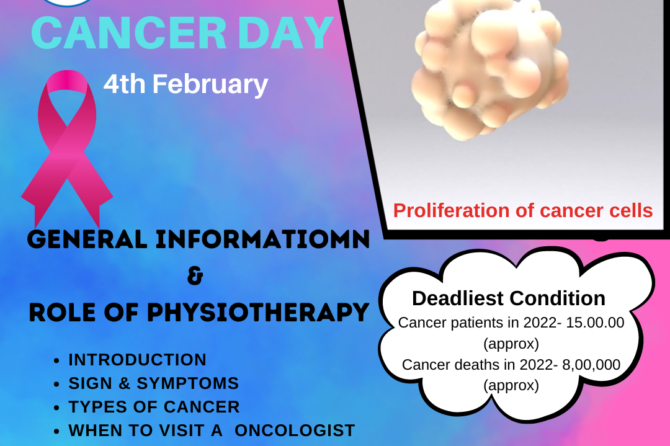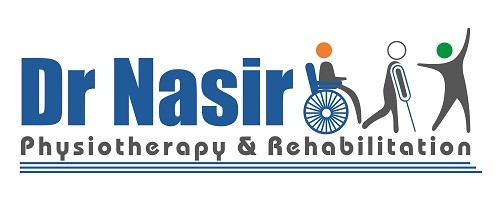
Cancer Rehabilitation in Delhi
Cancer Rehabilitation in Delhi
Cancer refers to any one of a large number of diseases characterized by the development of abnormal cells that divide uncontrollably and have the ability to infiltrate and destroy normal body tissue.
Cancer often has the ability to spread throughout your body.
Cancer is the second-leading cause of death in the world.
But survival rates are improving for many types of cancer, thanks to improvements in cancer screening, treatment, prevention, and Physiotherapy Rehabilitation.
Signs and Symptoms
• Pain
• Diminished energy
• Increased need for rest
• Limb heaviness
• Diminished ability to concentrate
• Decreased interest in engaging in normal activities
• Sleep disorder
• Inertia
• Emotional liability as a result of fatigue
• Perceived problems with short-term memory
• Post-exertional malaise exceeding several hours
Pain
• Pain is a very prevalent feature in cancer patients. According to recent studies, 28% of patients experience pain who are newly diagnosed with cancer, whereas 64% to 80% of people experience immense pain and have an advanced stage of the disease.
• Pain control is an absolute requisite for successful rehabilitation.
• Cancer patients generally experience multiple concurrent pain syndromes.
• Thorough evaluation requires assessment of all relevant pain etiologies and pathophysiologic processes.
Pain occurs in two forms in cancer patients namely acute pain, which generally arises after surgery and can be managed effectively through Physiotherapy otherwise it can hamper bodily movements and limit the joint range of motion.
We at DNPR, have been managing all cancer-related complications effectively and have treated many patients recently.
If untreated can lead to cancer-related complications which are among the widely spread after effects of any condition.
If you are searching for Cancer Rehabilitation in Delhi, then your search is over here.
At DNPR we have a team of physiotherapists for Cancer Rehabilitation in Delhi.
Cancer impairments
• Headache 49%
• Mental disturbance 32%
• Focal weakness 30%
• Gat ataxia 21%
• Seizures 18%
• Speech difficulty 12%
• Visual disturbance 6%
• Sensory disturbance 6%
• Limb ataxia 6%
Rehabilitation of Bone Metastasis
• Essentially de-weight or immobilize the compromised bones
• Integrated approach for the long-term management plan to offer patients the best chance of reserved comfort and function.
• Use of thoracolumbosacral or spinal extension orthosis.
• Patients with bone metastasis must consult a physiotherapist to ensure the range of mobility of the spine and safe exercises for patients with diffuse bone metastasis while redistributing weight and loading patterns.
• Assistive devices and instructions suggested by a physiotherapist like crutches, canes, and walkers to minimize the fracture risk.
• Patients can be instructed to minimize forces by performing activities close to the body.
• A comprehensive exercise program must be designed to include postural and balance training as well as truncal strengthening.
• Railings must be added to the stair walls and bathrooms of such patients.
• Exercises appear to exert a preventive effect against the development of some type of cancers.
• Benefits of exercise extend from immune function to the circulation of granulocytes and duration of neutropenia.
• Exercise promotes cardiopulmonary fitness, reduces fatigue improves the quality of life, depression, and anxiety.
• According to American research at least.
• 30 minutes of exercise for adults and 60 minutes of exercise for children can reduce the risk of cancer
Cardio Pulmonary rehabilitation.
• Exercise intolerance resulting from cardiopulmonary factors occurs commonly in cancer patients.
• Aerobic conditioning with supplemental oxygen is needed usually to produce a reduction and exertional intolerance.
• Improvements in stamina and perceived exertion are due to muscle training effects.
• In such cases, flexibility exercises can be done and the range of motion are very critical for the rehabilitation of post-surgical and post-radiation soft tissue contractures.
• Assistive range of motion activities that must target all affected muscle groups with emphasis placed on restricted. planes of motion and instructions to hold stretches for 3 to 5 deep breaths have been seen to produce significant changes in range of motion and improving the pattern of lifestyle.
Lymphedema Management
• Lymphedema is a chronic and currently incurable condition that frequently complicates cancer therapy after resection or radiation of lymph nodes and vessels.
- Lymphatic congestion can develop in any region of the body and that must be drained by affected structures
• Mostly seen cases of lymphedema become severe and result in swelling due to the accumulation of protein-rich fluid.
• Lymphedema management has phases. - Phase one is for the reduction wherein the primary goal is to reduce the lymphedema volume in such cases 45 minutes of manual lymphatic drainage followed by the application of compact compression bandages and performance of remedial exercises have been seen as effective.
• Phase 2 compressive garments are used during the day with the application of compressive bandages overnight to improve the lymphatic flow, Reduce accumulated proteins, improve wellness, shape up and reduce the size of the limb, maintain skin integrity, and prevent the limb from potential trauma.
• Stimulates intrinsic contractility of lymph vessels leading to an increased transformation of macromolecules in the interstitium.
Breast cancer functional impairments that are unique to breast cancer patients are generally developed after surgical positions for tumor removal and breast reconstruction.
Breast Cancer Rehabilitation
As a result of which axillary syndrome arises from its potential for painful restriction in shoulder range of motion in severe cases, the patient involves a decreased range of motion preventing the full shoulder flexion and abduction
The goals of post-breast cancer rehabilitation involve
• Prevention of subdermal fibrosis and adhesions
• Restoration of truncal alignment
• minimize the stress on the lumbar spine
• Optimize repair susceptive equity in residual abdominal muscles
• Increase normal muscle recruitment patterns
Rehabilitation of Head and Neck Cancer
It includes
• Neuromuscular training
• Preservation of trapezius muscle tone through electrical stimulation
• Postural modification
• Instruction in shoulder support to allow recovery of the levator scapulae
• Progressive fibrosis of anterior and lateral cervical soft tissue can be highly
problematic for head and neck cancer patients. Hence, a physiotherapist must work in a direction to control them
Prevention of frozen shoulder through an active range of motion.
Active range of motion
• Prevention of anterior chest wall flexibility deficits
• Active range of motion in the planes of neck motion should be initiated
• Cervical motion can continue throughout radiation therapy in the absence of significant skin breakdown
• Assisted activity should really begin immediately after surgery
• Stretches should be held for 5 deep breaths and repeated between 5 to 10 times per session
• Isometrics training must be carried out.
If you are searching for Cancer Rehabilitation in Delhi, then your search is over here.
At DNPR we have a team of physiotherapists for Cancer Rehabilitation in Delhi.








Leave a reply

Leave a reply